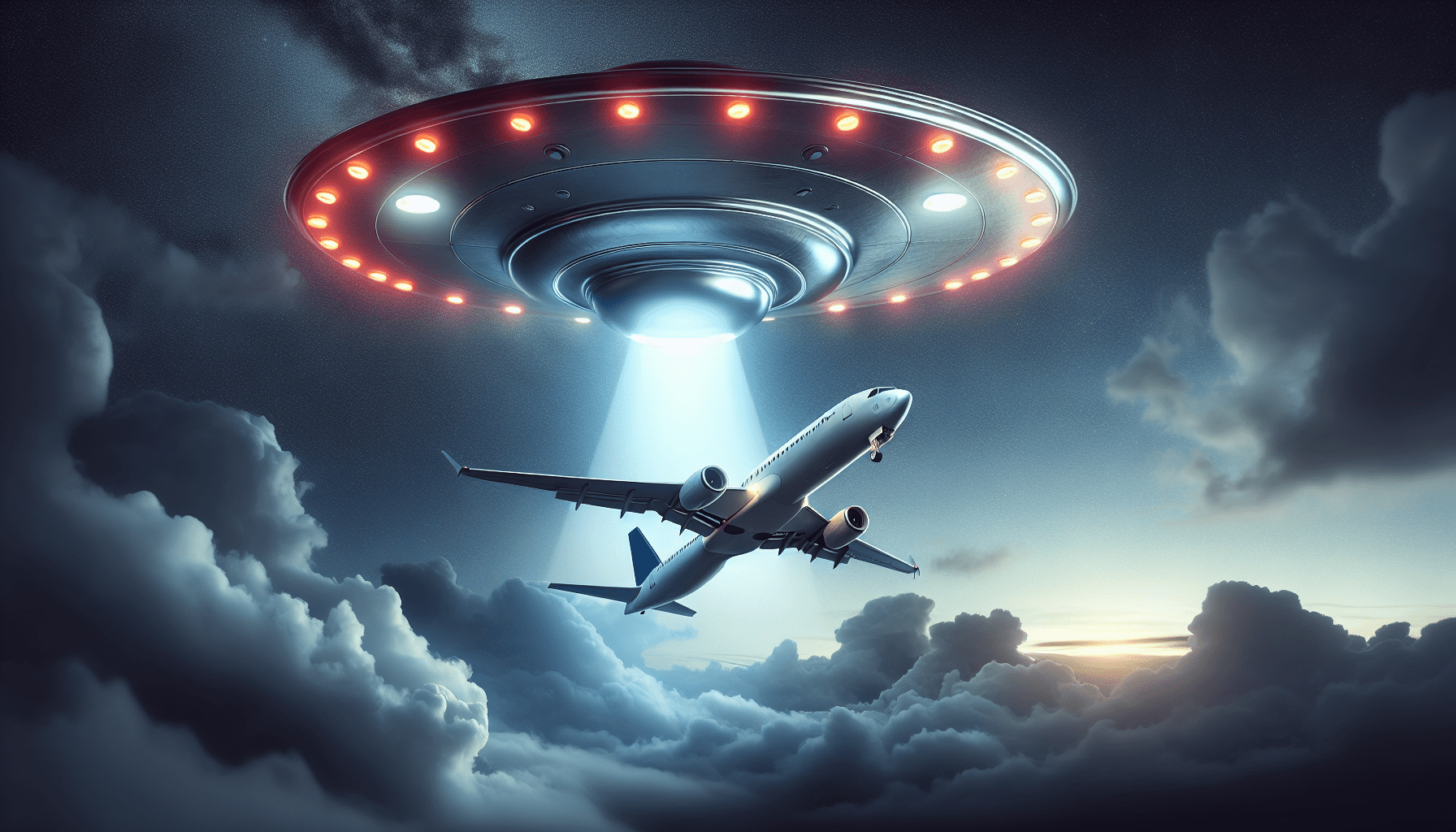Imagine this scenario: you’re lounging in your backyard, eyes fixed on the infinite expanse of the night sky. Suddenly, a peculiar object emerges, smoothly gliding through the stars. Is it a plane or perhaps something more extraordinary, like a UFO? Determining the answer could be an exhilarating challenge. In this article, we’ll equip you with simple yet effective tips to discern between UFOs and airplanes, ensuring that the next time you gaze at the heavens, you’ll have a better understanding of what’s soaring above you.

1. Shape and Structure
1.1 Physical Appearance
When it comes to differentiating between UFOs and airplanes, one of the first things to consider is their physical appearance. Most airplanes have a distinct shape and structure that is easily recognizable. They usually have a streamlined fuselage with wings attached to it. In contrast, UFOs often have unconventional shapes, which can vary greatly. They may appear as saucers, triangles, or even have no visible structure at all, appearing as a strange orb of light.
1.2 Wing Configuration
Looking at the wing configuration can also provide a clue when trying to differentiate between UFOs and airplanes. Airplanes typically have wings with a fixed position and predictable shape, such as straight wings, swept-back wings, or delta wings. UFOs, on the other hand, may not have visible wings at all. If wings are present, they may be asymmetrical or have an unusual shape, which is not commonly seen in traditional aircraft.
1.3 Fuselage Design
The design of the fuselage can also be an indicator when distinguishing between UFOs and airplanes. Airplanes generally have a well-defined fuselage, which houses the cockpit, passengers, and cargo. This fuselage is usually elongated and streamlined to reduce drag. UFOs, however, often lack a clearly defined fuselage or have a shape that is not commonly associated with traditional aircraft. They may have a more spherical or cylindrical form, making them stand out from the typical aircraft design.
1.4 Tail Design
Observing the tail design is another aspect to consider when differentiating between UFOs and airplanes. Airplanes typically have a horizontal stabilizer and a vertical fin, which provide stability and control during flight. These features are often visible and easily distinguishable. UFOs, on the other hand, may not have a tail design at all or exhibit unconventional tail configurations. They may also display peculiar movements that seem to defy traditional aerodynamic principles, further setting them apart from typical airplanes.
2. Lighting Patterns
2.1 Placement and Color
Looking at the lighting patterns can provide valuable information when trying to differentiate between UFOs and airplanes. Commercial airplanes are required to have specific lighting configurations for safety purposes. They usually have red lights on the left wing, green lights on the right wing, and a white light on the tail. These lights help other pilots identify the orientation and direction of the airplane. In contrast, UFOs often display irregular lighting patterns. They may have various colors, such as red, green, blue, or even multicolored lights. These lights may also move in an erratic or unpredictable manner, distinguishing them from traditional airplanes.
2.2 Flashing Patterns
The flashing patterns of lights can also be a useful clue when differentiating between UFOs and airplanes. Airplanes generally have consistent and repetitive flashing patterns that adhere to aviation regulations. These patterns include steady lights, blinking lights, and specific sequences that vary depending on the situation. UFOs, however, may exhibit unconventional and unpredictable flashing patterns. They may flash in irregular intervals, change colors abruptly, or even emit flashes in a seemingly random manner. These distinct patterns can help differentiate UFOs from traditional aircraft.
3. Speed and Maneuverability
3.1 Acceleration and Deceleration
Speed and maneuverability are crucial factors in distinguishing between UFOs and airplanes. While airplanes have defined acceleration and deceleration rates, UFOs often display remarkable speed changes. They can go from stationary to incredible speeds in an instant or suddenly come to a complete stop, defying the laws of physics. These rapid changes in velocity, which are not commonly observed in conventional aircraft, are indicative of UFOs.
3.2 Turning Radius
Examining the turning radius can also assist in differentiating between UFOs and airplanes. Airplanes have a fairly consistent turning radius, which depends on their size and flight characteristics. Their turns are usually smooth and predictable. In contrast, UFOs have been reported to make abrupt and sharp turns, often at high speeds. These sudden and unconventional movements, defying the laws of aerodynamics, can help identify a craft as a UFO rather than an ordinary airplane.
3.3 Flight Path
Analyzing the flight path is another factor to consider when trying to differentiate between UFOs and airplanes. Airplanes generally follow predetermined flight paths, such as established airways or flight corridors. They maintain a consistent and predictable trajectory. UFOs, however, often exhibit erratic flight patterns. They may change direction abruptly, hover in one place, or perform complex maneuvers that go beyond the capabilities of conventional aircraft. These unusual flight paths are a key characteristic of UFO sightings.

4. Sound Characteristics
4.1 Engine Noise
Sound characteristics can also offer valuable insights when distinguishing between UFOs and airplanes. Airplanes generate distinct engine noises that can often be heard when they are passing overhead or taking off and landing. These noises are usually consistent and recognizable, depending on the type of aircraft. UFOs, on the other hand, are often reported to be silent or emit a low humming sound. This lack of engine noise or the presence of an unusual and unfamiliar sound can indicate the presence of a UFO.
4.2 Doppler Effect
Another aspect to consider when differentiating between UFOs and airplanes is the Doppler effect. As an airplane approaches, passes by, and moves away, the pitch of its engine noise changes due to the Doppler effect. This change in sound frequency is a predictable occurrence. UFOs, however, may not exhibit the same Doppler effect. Witnesses often report a consistent pitch or lack of change in sound frequency, indicating a possible distinction from conventional aircraft.
5. Altitude and Movement
5.1 Altitude Assessment
Assessing the altitude of an object can be helpful in differentiating between UFOs and airplanes. Airplanes typically maintain specific altitudes depending on their flight phase and airspace regulations. They adhere to predetermined flight levels, transition altitudes, or approach and departure procedures. UFOs, however, may fly at various altitudes without following any specific patterns or regulations. They can hover at low altitudes or move at high speeds in the upper atmosphere, distinct from the typical behavior of airplanes.
5.2 Fixed Wing vs. Hovering
Determining whether the object has fixed wings or can hover in one place can also aid in distinguishing between UFOs and airplanes. Traditional airplanes rely on forward propulsion generated by their engines to stay airborne, and they are incapable of hovering. UFOs, however, have been widely reported to hover for extended periods of time without any apparent forward motion. This ability to remain stationary or move in any direction without conventional wing propulsion can indicate the presence of a UFO.
5.3 Vertical Ascent and Descent
Observing the vertical ascent and descent capabilities of an object is another consideration when differentiating between UFOs and airplanes. Airplanes generally follow a gradual ascent and descent path, which is necessary to maintain a safe and comfortable flight for passengers and cargo. UFOs, on the other hand, have been reported to exhibit highly rapid vertical movements. They can ascend or descend at extraordinary speeds, defying the laws of gravity. These sudden and impressive maneuvers distinguish UFOs from ordinary aircraft.
6. Performance Capabilities
6.1 Speed Limitations
Examining the speed limitations can also provide insights when trying to differentiate between UFOs and airplanes. Conventional airplanes have specific speed limitations depending on their type, design, and safety regulations. Whether it is a commercial airliner or a military fighter jet, their speeds are within known boundaries. UFOs, on the other hand, have been reported to move at incredible speeds that surpass the capabilities of any known aircraft. These exceptional velocities and accelerations are characteristics often associated with UFO sightings.
6.2 Aerobatic Maneuvers
Analyzing the aerobatic maneuvers performed by an object can also help differentiate between UFOs and airplanes. While airplanes are capable of performing aerobatic maneuvers such as loops, rolls, and stalls, these maneuvers are typically limited to specialized aircraft and are not commonly observed in everyday aviation. UFOs, however, have been reported to execute extraordinary and unconventional aerial maneuvers. These include sudden changes in direction, rapid acceleration, and other movements that defy the known principles of flight.
6.3 Takeoff and Landing
Observing the takeoff and landing characteristics can further assist in differentiating between UFOs and airplanes. Airplanes follow established procedures for takeoff and landing, which involve specific runway configurations and landing gear operations. These actions are usually visible and recognizable. UFOs, however, have been reported to exhibit unique takeoff and landing behaviors. Witnesses often describe UFOs hovering before suddenly shooting up into the sky or descending rapidly without any visible landing gear. These extraordinary takeoff and landing characteristics set UFOs apart from conventional aircraft.
7. Communication Signals
7.1 Radio Transmissions
Monitoring radio transmissions can be a valuable tool in distinguishing between UFOs and airplanes. Airplanes communicate via radio with air traffic control, sharing their position, altitude, and intentions. These radio transmissions are part of regulated procedures and can be intercepted by radio scanners. UFOs, however, are generally not known to emit or respond to radio signals or air traffic control communications. The absence of any radio transmissions from an object can suggest that it is not an ordinary airplane.
7.2 Flight Control Interaction
Examining the interaction with flight control systems can also aid in differentiating between UFOs and airplanes. Airplanes are in constant communication with air traffic controllers, adhering to their instructions and flight clearances. The movements and flight paths of airplanes are closely monitored and controlled by these systems. UFOs, on the other hand, do not typically exhibit any interaction with flight control systems. They often move independently of any known flight regulations or control, further indicating their distinction from conventional aircraft.
8. Technological Features
8.1 Radar Tracking
Tracking an object on radar can provide additional insights when trying to differentiate between UFOs and airplanes. Airplanes are known to appear on radar screens as blips or targets, confirming their presence and location. These radar systems are crucial for air traffic control and monitoring aircraft movements. UFOs, on the other hand, may not appear on radar or exhibit unusual radar signatures. They can often evade detection or display movements that challenge the capabilities of radar systems, distinguishing them from conventional airplanes.
8.2 Heat Signature
Examining the heat signature emitted by an object can also help differentiate between UFOs and airplanes. Airplanes generate heat signatures due to the operation of their engines and systems. These signatures can be picked up by thermal imaging cameras and infrared sensors. UFOs, however, may not emit the same level of heat or have irregular heat patterns. Witnesses often report a lack of heat or unusual heat emissions from UFOs, setting them apart from ordinary aircraft.
8.3 Infrared Signatures
Analyzing the infrared signatures can also offer insights when differentiating between UFOs and airplanes. Infrared imaging technology can capture the heat emitted by objects, aiding in their identification. Airplanes usually have distinct infrared signatures due to their specific structures and engine operations. UFOs, on the other hand, may exhibit irregular or unidentified infrared signatures. These signatures can differ from anything commonly associated with conventional aircraft, further distinguishing UFOs from airplanes.
9. Presence of Identifiable Markings
9.1 Company Logos or Livery
The presence of identifiable markings on an object can be helpful in distinguishing between UFOs and airplanes. Airplanes commonly display company logos, livery, or paint schemes that identify the airline or operator. These markings are visible on the exterior of the aircraft and can be easily recognized. UFOs, however, generally lack any identifiable logos or livery. They often appear as unmarked objects or exhibit unconventional and unidentifiable markings, making them stand out from traditional aircraft.
9.2 Registration Numbers
Taking note of registration numbers can also aid in differentiating between UFOs and airplanes. Airplanes are required to display registration numbers, also known as tail numbers, on their exterior. These alphanumeric codes identify the specific aircraft and provide important information for tracking and regulatory purposes. UFOs, on the other hand, do not have visible registration numbers. They often lack any identifiable markings or exhibit markings that do not conform to the standard registration system, further distinguishing them from ordinary aircraft.
10. Observational Context
10.1 Time of Day
Considering the time of day can contribute to the differentiation between UFOs and airplanes. Airplane sightings are most common during the day when the sky is well-lit, and visibility is optimal. UFO sightings, however, can occur at any time of day or night. Many documented sightings have taken place during the evening or night when the sky is dark. This distinction in the timing of sightings can help distinguish between ordinary airplanes and unexplained aerial phenomena.
10.2 Weather Conditions
Assessing the weather conditions is another important factor when trying to differentiate between UFOs and airplanes. Airplanes are designed to operate within specific weather limitations and can be affected by adverse weather conditions. They often adjust their flight paths or delay flights due to poor weather. UFOs, on the other hand, have been reported in various weather conditions, including clear skies, cloudy weather, and even during storms. Their presence in severe weather conditions or their ability to perform unusual maneuvers despite weather constraints can indicate their differentiation from ordinary airplanes.
10.3 Surrounding Environment
Taking the surrounding environment into account is also crucial when differentiating between UFOs and airplanes. Airplanes typically operate in designated airspace, follow established flight paths, and are often observed near airports or other aviation infrastructure. UFOs, on the other hand, can appear in any environment, including remote locations, cities, or even densely populated areas. They can also be seen in proximity to ordinary airplanes but exhibit behavior or characteristics that distinguish them as unidentified objects.
In conclusion, when trying to differentiate between UFOs and airplanes, it is essential to consider various factors such as shape and structure, lighting patterns, speed and maneuverability, sound characteristics, altitude and movement, performance capabilities, communication signals, technological features, identifiable markings, and the observational context. By analyzing these aspects, one can better distinguish between ordinary airplanes and unidentified objects, further contributing to the understanding of unexplained aerial phenomena.

